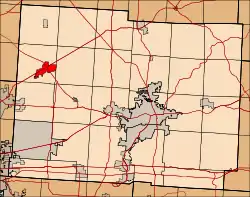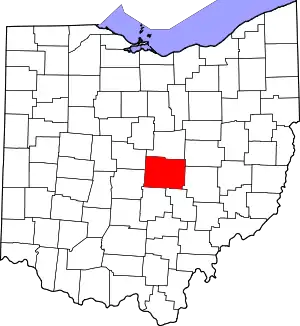Johnstown, Ohio
Johnstown is a village in Licking County, Ohio, United States. The population was 4,632 at the 2010 census.
Johnstown, Ohio | |
|---|---|
 Community building on the public square | |
 Location of Johnstown, Ohio | |
 Location of Johnstown in Licking County | |
| Coordinates: 40°8′57″N 82°41′12″W | |
| Country | United States |
| State | Ohio |
| County | Licking |
| Area | |
| • Total | 2.99 sq mi (7.76 km2) |
| • Land | 2.98 sq mi (7.73 km2) |
| • Water | 0.01 sq mi (0.03 km2) |
| Elevation | 1,152 ft (351 m) |
| Population | |
| • Total | 4,632 |
| • Estimate (2019)[4] | 5,098 |
| • Density | 1,707.87/sq mi (659.52/km2) |
| Time zone | UTC-5 (Eastern (EST)) |
| • Summer (DST) | UTC-4 (EDT) |
| ZIP code | 43031 |
| Area code(s) | 740 |
| FIPS code | 39-39340[5] |
| GNIS feature ID | 1048875[2] |
| Website | http://www.johnstownohio.org/ |
The village is currently served by a seven-person Village Council which includes the current Mayor Charles “Chip” Dutcher.
Johnstown was the home of William A. Ashbrook, an American businessman, newspaper publisher, and Democratic politician from Ohio. His son, John Ashbrook, was elected to the Ohio House of Representatives in 1956, and in 1960 won his father's old seat in the U.S. House of Representatives as the Republican candidate. In the 1972 presidential election, John Ashbrook ran against incumbent Richard Nixon in some state primaries as an alternative conservative candidate.
History
The Village of Johnstown is part of a four thousand acre (16 km2) tract of land deeded to James Charles, a revolutionary soldier, by President John Adams for military services in 1800. Brown sold the property in 1810 for $2.50 per acre to Dr. Oliver Bigelow. Dr. Bigelow laid out and incorporated the village of Johnstown, donating the streets, alleys and the town square. In 1926 a nearly complete skeleton of a mastodon was found by a farmer named James Bailey, and subsequently sold to the Cleveland Museum of Natural History.[6]
Geography
Johnstown is located at 40°8′57″N 82°41′12″W (40.149075, −82.686710).[7]
According to the United States Census Bureau, the village has a total area of 2.91 square miles (7.54 km2), of which 2.90 square miles (7.51 km2) is land and 0.01 square miles (0.03 km2) is water.[8]
Demographics
| Historical population | |||
|---|---|---|---|
| Census | Pop. | %± | |
| 1830 | 217 | — | |
| 1860 | 241 | — | |
| 1870 | 241 | 0.0% | |
| 1880 | 278 | 15.4% | |
| 1890 | 424 | 52.5% | |
| 1900 | 638 | 50.5% | |
| 1910 | 805 | 26.2% | |
| 1920 | 906 | 12.5% | |
| 1930 | 1,006 | 11.0% | |
| 1940 | 1,064 | 5.8% | |
| 1950 | 1,220 | 14.7% | |
| 1960 | 2,881 | 136.1% | |
| 1970 | 3,208 | 11.4% | |
| 1980 | 3,158 | −1.6% | |
| 1990 | 3,242 | 2.7% | |
| 2000 | 3,440 | 6.1% | |
| 2010 | 4,632 | 34.7% | |
| 2019 (est.) | 5,098 | [4] | 10.1% |
| US Census[9] | |||
2010 census
As of the census[3] of 2010, there were 4,632 people, 1,891 households, and 1,217 families living in the village. The population density was 1,597.2 inhabitants per square mile (616.7/km2). There were 1,994 housing units at an average density of 687.6 per square mile (265.5/km2). The racial makeup of the village was 97.1% White, 0.6% African American, 0.5% Native American, 0.5% Asian, 0.4% from other races, and 0.9% from two or more races. Hispanic or Latino of any race were 1.8% of the population.
There were 1,891 households, of which 33.9% had children under the age of 18 living with them, 45.5% were married couples living together, 13.8% had a female householder with no husband present, 5.1% had a male householder with no wife present, and 35.6% were non-families. 29.7% of all households were made up of individuals, and 11.6% had someone living alone who was 65 years of age or older. The average household size was 2.42 and the average family size was 3.00.
The median age in the village was 35.6 years. 26.7% of residents were under the age of 18; 7.5% were between the ages of 18 and 24; 29% were from 25 to 44; 23.3% were from 45 to 64, and 13.5% were 65 years of age or older. The gender makeup of the village was 47.5% male and 52.5% female.
2000 census
As of the census[5] of 2000, there were 3,440 people, 1,396 households, and 932 families living in the village. The population density was 1,643.0 people per square mile (635.5/km2). There were 1,453 housing units at an average density of 694.0 per square mile (268.4/km2). The racial makeup of the village was 98.49% White, 0.15% African American, 0.29% Native American, 0.15% Asian, 0.23% from other races, and 0.70% from two or more races. Hispanic or Latino of any race were 0.44% of the population.
There were 1,396 households, out of which 35.2% had children under the age of 18 living with them, 50.1% were married couples living together, 12.7% had a female householder with no husband present, and 33.2% were non-families. 29.1% of all households were made up of individuals, and 12.7% had someone living alone who was 65 years of age or older. The average household size was 2.42 and the average family size was 2.98.
In the village, the population was spread out, with 26.0% under the age of 18, 8.3% from 18 to 24, 29.5% from 25 to 44, 21.6% from 45 to 64, and 14.6% who were 65 years of age or older. The median age was 36 years. For every 100 females, there were 90.1 males. For every 100 females age 18 and over, there were 85.4 males.
The median income for a household in the village was $43,651, and the median income for a family was $55,326. Males had a median income of $37,344 versus $25,543 for females. The per capita income for the village was $19,777. About 4.3% of families and 7.6% of the population were below the poverty line, including 9.6% of those under age 18 and 8.2% of those age 65 or over.
Education
Johnstown-Monroe Local School District operates one elementary school, one middle school, and Johnstown-Monroe High School.[10]
Johnstown has a public library, a branch of the Licking County Library System.[11]
References
- "2019 U.S. Gazetteer Files". United States Census Bureau. Retrieved July 28, 2020.
- "US Board on Geographic Names". United States Geological Survey. October 25, 2007. Retrieved January 31, 2008.
- "U.S. Census website". United States Census Bureau. Retrieved January 6, 2013.
- "Population and Housing Unit Estimates". Retrieved May 21, 2020.
- "U.S. Census website". United States Census Bureau. Retrieved January 31, 2008.
- http://www.villageofjohnstown.org/history.html
- "US Gazetteer files: 2010, 2000, and 1990". United States Census Bureau. February 12, 2011. Retrieved April 23, 2011.
- "US Gazetteer files 2010". United States Census Bureau. Archived from the original on July 2, 2012. Retrieved January 6, 2013.
- Data in historical populations table from US Census, 1890, 1891; US Census, 1920, 1921; US Census, 1950, 1952; US Census, 1970, 1973; US Census, 2000, ISBN 9781428986060; "U.S. Census website". US Census Bureau..
- "Johnstown-Monroe Local School District". GreatSchools. Retrieved February 26, 2018.
- "Hours & Locations". Licking County Library System. Retrieved February 26, 2018.
External links
| Wikimedia Commons has media related to Johnstown, Ohio. |
